|
|
COURTS
Many courts and court-related tribunals operate throughout Australia. The majority of courts handle matters that are criminal or civil in nature, while tribunals provide a less costly alternative for progressing some civil and administrative matters outside the formality of a court. A criminal matter generally arises where a charge has been laid either by police or some other prosecuting authority on the basis of a breach of criminal law. A civil matter occurs where there is a dispute between two or more individuals or organisations, where one party seeks legal remedy for an injury or loss from the other party who is alleged to be liable.
There are many other types of courts and tribunals in operation, commonly referred to as specialist courts and tribunals. Examples of these include the Coroners' Courts, Family Court, Federal Magistrates' Court, Drug Courts, Domestic Violence Courts, Workers' Compensation Commissions/Tribunals, Industrial Relations Commission, Small Claims Tribunals, Administrative Appeals Tribunal and Residential Tenancy Tribunal.
Courts and tribunals tend to be arranged in a hierarchy (diagram 11.22), with the majority of less serious matters being heard before magistrates and more serious matters being heard before judges. For criminal matters the seriousness is often determined by the nature of the alleged offence. In a civil context, seriousness is generally determined according to the amount being sought in compensation. A court's or tribunal's ability to deal with a civil, criminal or other matter will depend on the state or territory's legislation or jurisdiction applicable to that particular level of court.
The hierarchy of courts also applies to appeal matters. Where grounds for appeal exist, the appeal process is available in both criminal and civil matters. Appeals resulting from civil tribunal decisions may be referred to the Magistrates', District/County, Supreme or Commonwealth Courts, depending on the jurisdiction and the right of appeals. Criminal appeals resulting from the Magistrates' Court can be appealed at the District/County, Supreme or Commonwealth Court level in the first instance. The High Court of Australia is the highest court of appeal for both criminal and civil cases.
11.22 HIERARCHY OF COURTS
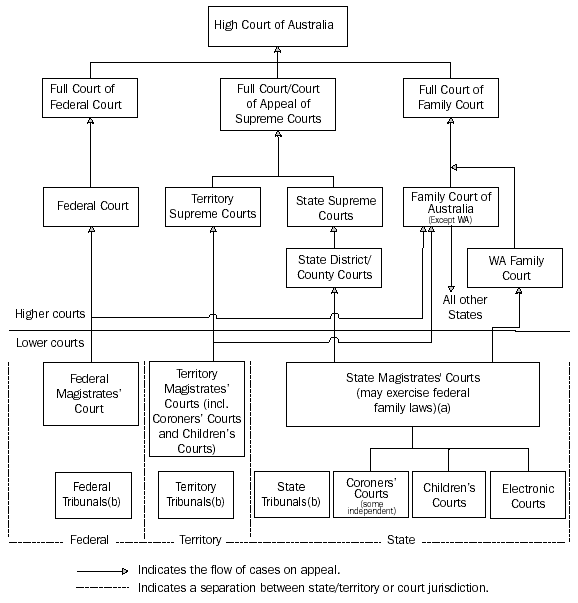
(a) In some jurisdictions, appeals from lower courts may go directly to the court of appeal in the Supreme Court. In the ACT, the court of appeal of the Supreme Court commenced exercising limited jurisdiction on 31 October 2001; full jurisdiction did not commence until 14 October 2002.
(b) Appeals from federal, state and territory tribunals may go to any higher court in their jurisdiction.
Source: Steering Committee for the Review of Commonwealth/State Service Provision, Report on Government Services 2005.
CRIMINAL COURTS
A system of courts for the hearing of criminal matters exists in all Australian states and territories. Once charges are laid by police, the court will hear evidence by both prosecution and defence, and will make a decision as to whether or not the defendant is guilty. In cases where the defendant is found guilty, the court may also record a conviction and impose a penalty.
The lowest level of criminal court is the Magistrates' Court or Court of Summary Jurisdiction. The majority of all criminal cases are heard in these courts. Cases heard in Magistrates' Courts do not involve a jury and a magistrate determines the guilt or innocence of the defendant. This is known as a summary proceeding. Relatively minor offences such as property damage or minor road traffic offences can be dealt with in this way. More serious offences are dealt with by the higher court levels.
All states and territories have a Supreme Court that can deal with all criminal matters. The larger jurisdictions also have an intermediate level of court, known as the District or County Court, that deals with the majority of serious offences. The Supreme Courts and Intermediate Courts are collectively referred to as the Higher Courts.
All offences that are dealt with by the Higher Courts have an automatic entitlement to a trial before a judge and jury. In some jurisdictions, the defendant may elect to have the matter heard before a judge alone. Offences that must be heard before a judge and jury are known as indictable offences. These include offences such as murder, manslaughter and drug importation as well as serious sexual offences, robberies and assaults.
A defendant proven guilty in a criminal matter is entitled to appeal against the conviction or against the severity of penalty imposed. Under some circumstances, the prosecution is also entitled to appeal against the leniency of the penalty. The states and territories differ in the ways in which they deal with appeals. Some appeals from Magistrates' Courts may be heard before the Intermediate Courts. In other jurisdictions the Supreme Court may hear these appeals. In most jurisdictions an appeal court or Court of Criminal Appeal may be constituted to hear appeals from the Supreme or Intermediate Courts, with the highest court of appeal for all jurisdictions being the High Court of Australia.
National criminal courts statistics
The aim of the Criminal Courts collection is to provide comparable statistics for the states and territories and for Australia on the characteristics of defendants dealt with by the Criminal Courts. This includes information on the offences and sentences associated with those defendants. In order to ensure consistency between the states and territories, the statistics have been compiled according to national standards and classifications. However, some legislative and processing differences may limit the degree to which the statistics are comparable across the states and territories. Differences may also arise as a result of other factors, including refinements in data quality procedures and modifications in the systems used to obtain and compile the figures.
Criminal courts defendant summary characteristics
Diagram 11.23 presents summary characteristics of defendants dealt with by the Higher and Magistrates' Courts of Australia. 'Finalised defendant' refers to all charges against a person or organisation having been formally completed so that the defendant ceases to be an item of work to be dealt with by a particular court. Adjudication is a method of finalisation based on a judgement or decision by the court as to whether or not a defendant is guilty of the charge(s) laid against them.
In 2003-04, 544,689 defendants were finalised in the Higher and Magistrates' Courts. Of these, 17,315 (3%) were in the Higher Courts and 527,374 (97%) were in the Magistrates' Courts.
The majority (87% or 15,003) of defendants finalised in the Higher Courts during 2003-04 were adjudicated. Those proven guilty comprised 93% (13,950) of all adjudications, while acquittals comprised 7% (1,053) of the total. Of those proven guilty, 90% pleaded guilty and 10% were declared guilty at trial. The remaining defendants (13%) were finalised by a non-adjudicated method such as all charges withdrawn by the prosecution.
The Magistrates' Courts finalised 527,374 defendants during 2003-04. Adjudications comprised 88% (466,661) of all finalisations. Defendants proven guilty (i.e. pleaded guilty or were declared guilty) and defendants acquitted comprised 96% and 4% respectively of all adjudications. Non-adjudicated methods (such as all charges withdrawn by the prosecution or transferred to another court level) comprised 12% of finalised defendants.
11.23 CRIMINAL COURT FINALISATIONS - 2003-04
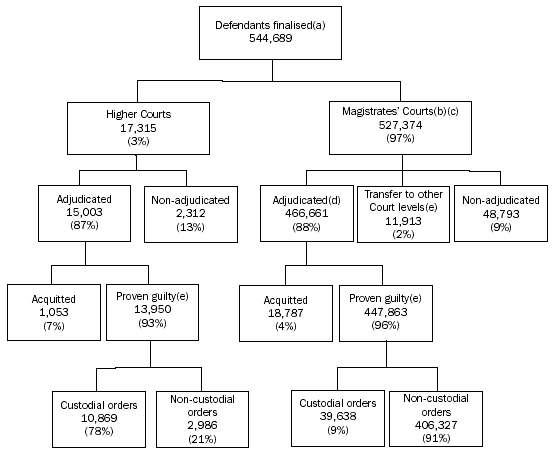
(a) Defendants will be counted twice where they are transferred from the Magistrates' Court to a Higher Court and then finalised in the Higher Court in the same reference period. (b) Includes defendants with an unknown method of finalisation. (c) Excludes defendants finalised by committal or transfer to a Higher Court and refers to finalised appearances rather than finalised defendants in Magistrates' Court in New South Wales. (d) Includes defendants adjudicated n.f.d. (e) Includes defendants for whom a principal sentence is unknown.
Source: Criminal Courts, Australia, 2003-04 (4513.0).
Criminal courts finalisations
For combined court levels, New South Wales, Queensland and Victoria accounted for 70% of finalisations nationally (28%, 24% and 17% respectively). Queensland accounted for the highest proportions of finalisations for the Higher Courts (40%) and New South Wales for the highest proportion of finalisations in the Magistrates' Courts (28%) (table 11.24).
11.24 CRIMINAL COURT FINALISATIONS, By court level - 2003-04
|
 | NSW(a) | Vic. | Qld | SA | WA | Tas. | NT | ACT | Aust. |
|
NUMBER |
|
 |  |  |  |  |  |  |  |  |  |
| Higher Courts | 3,456 | 2,548 | 6,863 | 869 | 2,667 | 537 | 256 | 119 | 17,315 |
| Magistrates' Courts(b) | 146,950 | 90,572 | 129,029 | 43,326 | 58,589 | 46,723 | 7,048 | 5,137 | 527,374 |
| Total(b)(c) | 150,406 | 93,120 | 135,892 | 44,195 | 61,256 | 47,260 | 7,304 | 5,256 | 544,689 |
|
PROPORTION (%) |
|
 |  |  |  |  |  |  |  |  |  |
| Higher Courts | 20.0 | 14.7 | 39.6 | 5.0 | 15.4 | 3.1 | 1.5 | 0.7 | 100.0 |
| Magistrates' Courts(b) | 27.9 | 17.2 | 24.4 | 8.2 | 11.1 | 8.9 | 1.3 | 1.0 | 100.0 |
| Total(b)(c) | 27.6 | 17.1 | 24.4 | 8.1 | 11.2 | 8.7 | 1.3 | 1.0 | 100.0 |
|
(a) Refers to finalised appearances rather than finalised defendants in the Magistrates' Court, resulting in a possible increase in the population counts.
(b) Excludes defendants finalised by committal or transfer to a Higher court in NSW.
(c) Defendants will be counted twice where they are transferred from the Magistrates' Court to a Higher Court and then finalised in the Higher Court within the same reference period.
Source: Criminal Courts, Australia, 2003-04 (4513.0). |
The number of defendants finalised in the Higher Courts increased by 4% from 16,643 defendants in 2002-03 to 17,315 defendants in 2003-04. Finalisations of defendants decreased in Western Australia (8%), Tasmania (11%) and the Australian Capital Territory (27%) (table 11.25).
11.25 TOTAL HIGHER CRIMINAL COURT FINALISATIONS
|
 | 1996-97 | 1997-98 | 1998-99 | 1999-2000 | 2000-01 | 2001-02 | 2002-03(a) | 2003-04(a) |
|
| NSW | 3,584 | 3,961 | 4,186 | 4,300 | 3,917 | 3,654 | 3,204 | 3,456 |
| Vic. | 1,631 | 1,737 | 1,977 | 2,277 | 2,147 | 1,993 | 2,078 | 2,548 |
| QLD | 6,264 | 6,477 | 7,595 | 7,379 | 6,932 | 7,230 | 6,630 | 6,863 |
| SA | 1,299 | 1,004 | 943 | 936 | 928 | 1,131 | 821 | 869 |
| WA | 2,228 | 2,718 | 2,893 | 3,113 | 3,055 | 3,070 | 2,885 | 2,667 |
| Tas. | 322 | 337 | 611 | 749 | 441 | 486 | 605 | 537 |
| NT | 206 | 311 | 288 | 268 | 404 | 262 | 256 | 256 |
| ACT | 150 | 138 | 161 | 190 | 205 | 171 | 164 | 119 |
| Australia | 15,684 | 16,683 | 18,654 | 19,212 | 18,029 | 17,997 | 16,643 | 17,315 |
|
(a) Excludes defendants finalised by a bench warrant being issued.
Source: Criminal Courts, Australia, 2003-04 (4513.0). |
Males represented the majority of finalised defendants (78% or 425,880) in the Higher and Magistrates' courts during 2003-04. Half (269,924) the total number of these finalised defendants were males aged less than 35 years of age. Males in the 20-24 year age group had the highest number of finalised male defendants (94,797) while the 35-44 year age group was the highest for females (22,612) (table 11.26).
11.26 FINALISED DEFENDANTS, By age group
|
 | Under 20
years | 20-24
years | 25-29
years | 30-34
years | 35-44
years | 45 years
and over | Total(a) |
|
HIGHER COURTS |
|
 |  |  |  |  |  |  |  |
| Males | 1,522 | 3,443 | 2,557 | 2,271 | 2,955 | 2,203 | 15,005 |
| Females | 171 | 536 | 388 | 371 | 539 | 276 | 2,292 |
| Persons(b) | 1,693 | 3,979 | 2,945 | 2,642 | 3,494 | 2,479 | 17,315 |
|
MAGISTRATES' COURTS(c) |
|
 |  |  |  |  |  |  |  |
| Males | 45,873 | 91,354 | 65,833 | 57,071 | 75,562 | 56,593 | 410,875 |
| Females | 8,644 | 19,568 | 16,316 | 15,576 | 22,073 | 13,599 | 104,246 |
| Persons(b) | 54,638 | 111,328 | 82,489 | 72,873 | 97,969 | 70,509 | 527,374 |
|
HIGHER AND MAGISTRATES' COURTS(c)(d) |
|
 |  |  |  |  |  |  |  |
| Males | 47,395 | 94,797 | 68,390 | 59,342 | 78,517 | 58,796 | 425,880 |
| Females | 8,815 | 20,104 | 16,704 | 15,947 | 22,612 | 13,875 | 106,538 |
| Persons(b) | 56,331 | 115,307 | 85,434 | 75,515 | 101,463 | 72,988 | 544,689 |
|
(a) Includes defendants with unknown age.
(b) Includes organisations and persons with unknown sex.
(c) Excludes defendants finalised by committal or transfer to a Higher Court in NSW.
(d) Defendants will be counted twice where they are transferred from the Magistrates' Court to a Higher Court and then finalised in the Higher Court within the same reference period.
Source: Criminal Courts, Australia, 2003-04 (4513.0). |
ADJUDICATED DEFENDANTS - PRINCIPAL OFFENCE
Defendants were more likely to be adjudicated in the Higher Courts during 2003-04 for the following categories of principal offences, using Divisions of the Australian Criminal Standard Offence Classification (ASOC): Acts intended to cause injury (21%); Unlawful entry with intent/burglary, break and enter (15%); Illicit drug offences (14%); and Robbery, extortion and related offences, and Sexual assault and related offences (both 11%) (table 11.27). There were 10,732 (72%) defendants adjudicated by the Higher Courts with a principal offence in one of these five categories.
11.27 HIGHER CRIMINAL COURTS ADJUDICATED DEFENDANTS, Principal offence - 2003-04
|
 | Age group (years) |  |
 |
|  |
| ASOC Division(a) | Under 20 | 20-24 | 25-29 | 30-34 | 35-44 | 45 and over | Total(b) |
|
NUMBER |
|
| Homicide and related offences | 34 | 79 | 65 | 65 | 98 | 77 | 421 |
| Acts intended to cause injury | 326 | 761 | 599 | 538 | 614 | 270 | 3,114 |
| Sexual assault and related offences | 81 | 185 | 169 | 182 | 414 | 543 | 1,577 |
| Dangerous or negligent acts endangering persons | 55 | 154 | 94 | 64 | 61 | 46 | 474 |
| Abduction and related offences | 8 | 25 | 27 | 18 | 21 | 13 | 112 |
| Robbery, extortion and related offences | 361 | 613 | 302 | 182 | 172 | 48 | 1,685 |
| Unlawful entry with intent/burglary, break and enter | 401 | 724 | 431 | 342 | 279 | 66 | 2,246 |
| Theft and related offences | 77 | 216 | 140 | 124 | 137 | 91 | 792 |
| Deception and related offences | 24 | 156 | 171 | 169 | 309 | 263 | 1,101 |
| Illicit drug offences | 48 | 343 | 362 | 375 | 564 | 414 | 2,110 |
| Weapons and explosives offences | 3 | 12 | 15 | 12 | 11 | 15 | 68 |
| Property damage and environmental pollution | 75 | 91 | 60 | 53 | 61 | 37 | 383 |
| Public order offences | 14 | 45 | 43 | 40 | 47 | 25 | 217 |
| Road traffic and motor vehicle regulatory offences | - | - | - | - | - | - | - |
| Offences against justice procedures, government security and government operations | 15 | 74 | 48 | 50 | 54 | 33 | 274 |
| Miscellaneous offences | 9 | 41 | 54 | 48 | 68 | 58 | 297 |
| All offence categories(c) | 1,539 | 3,541 | 2,597 | 2,283 | 2,939 | 2,026 | 14,998 |
|
PROPORTION (%) |
|
| Homicide and related offences | 2.2 | 2.2 | 2.5 | 2.8 | 3.3 | 3.8 | 2.8 |
| Acts intended to cause injury | 21.2 | 21.5 | 23.1 | 23.6 | 20.9 | 13.3 | 20.8 |
| Sexual assault and related offences | 5.3 | 5.2 | 6.5 | 8.0 | 14.1 | 26.8 | 10.5 |
| Dangerous or negligent acts endangering persons | 3.6 | 4.3 | 3.6 | 2.8 | 2.1 | 2.3 | 3.2 |
| Abduction and related offences | 0.5 | 0.7 | 1.0 | 0.8 | 0.7 | 0.6 | 0.7 |
| Robbery, extortion and related offences | 23.5 | 17.3 | 11.6 | 8.0 | 5.9 | 2.4 | 11.2 |
| Unlawful entry with intent/burglary, break and enter | 26.1 | 20.4 | 16.6 | 15.0 | 9.5 | 3.3 | 15.0 |
| Theft and related offences | 5.0 | 6.1 | 5.4 | 5.4 | 4.7 | 4.5 | 5.3 |
| Deception and related offences | 1.6 | 4.4 | 6.6 | 7.4 | 10.5 | 13.0 | 7.3 |
| Illicit drug offences | 3.1 | 9.7 | 13.9 | 16.4 | 19.2 | 20.4 | 14.1 |
| Weapons and explosives offences | 0.2 | 0.3 | 0.6 | 0.5 | 0.4 | 0.7 | 0.5 |
| Property damage and environmental pollution | 4.9 | 2.6 | 2.3 | 2.3 | 2.1 | 1.8 | 2.6 |
| Public order offences | 0.9 | 1.3 | 1.7 | 1.8 | 1.6 | 1.2 | 1.4 |
| Road traffic and motor vehicle regulatory offences | - | - | - | - | - | - | - |
| Offences against justice procedures, government security and government operations | 1.0 | 2.1 | 1.8 | 2.2 | 1.8 | 1.6 | 1.8 |
| Miscellaneous offences | 0.6 | 1.2 | 2.1 | 2.1 | 2.3 | 2.9 | 2.0 |
| All offence categories(c) | 100.0 | 100.0 | 100.0 | 100.0 | 100.0 | 100.0 | 100.0 |
|
(a) Australian Standard Offence Classification.
(b) Includes defendants with unknown age.
(c) Includes defendants for whom offence data were missing or a principal offence could not be determined.
Source: Criminal Courts, Australia, 2003-04 (4513.0). |
In contrast, the five categories of principal offences that accounted for the majority of adjudicated defendants in the Magistrates' Courts in 2003-04 were: Road traffic and motor vehicle regulatory offences (44%); Public order offences (9%); Theft and related offences (8%); and Acts intended to cause injury and Dangerous or negligent acts endangering persons (both 7%). Overall, approximately three out of every four defendants adjudicated in the Magistrates' Courts had one of these five categories of principal offences (table 11.28).
11.28 MAGISTRATES' CRIMINAL COURTS ADJUDICATED DEFENDANTS, Principal offence - 2003-04
|
 | Age group (years) |  |
 |
|  |
| ASOC Division(a) | Under 20 | 20-24 | 25-29 | 30-34 | 35-44 | 45 and over | Total(b) |
|
NUMBER |
|
| Homicide and related offences | 5 | 26 | 17 | 13 | 24 | 24 | 109 |
| Acts intended to cause injury | 3,000 | 6,962 | 5,810 | 5,620 | 7,632 | 3,897 | 32,994 |
| Sexual assault and related offences | 33 | 103 | 79 | 116 | 231 | 302 | 871 |
| Dangerous or negligent acts endangering persons | 4,839 | 8,261 | 5,116 | 4,064 | 5,753 | 5,086 | 33,348 |
| Abduction and related offences | - | 8 | 7 | 5 | 9 | 6 | 35 |
| Robbery, extortion and related offences | 112 | 91 | 45 | 52 | 36 | 9 | 345 |
| Unlawful entry with intent/burglary, break and enter | 1,630 | 2,231 | 1,462 | 1,023 | 948 | 227 | 7,538 |
| Theft and related offences | 6,748 | 9,143 | 6,312 | 5,338 | 6,525 | 4,160 | 38,364 |
| Deception and related offences | 1,648 | 3,679 | 3,020 | 2,527 | 3,212 | 2,275 | 16,857 |
| Illicit drug offences | 3,015 | 6,750 | 5,299 | 4,738 | 5,955 | 2,556 | 28,355 |
| Weapons and explosives offences | 750 | 1,292 | 899 | 842 | 1,357 | 1,169 | 6,331 |
| Property damage and environmental pollution | 2,393 | 3,422 | 2,088 | 1,703 | 1,932 | 866 | 12,800 |
| Public order offences | 7,193 | 10,894 | 6,803 | 5,786 | 7,721 | 4,147 | 43,322 |
| Road traffic and motor vehicle regulatory offences | 15,694 | 42,470 | 31,913 | 27,572 | 37,933 | 31,967 | 205,672 |
| Offences against justice procedures, government security and government operations | 2,417 | 4,376 | 3,776 | 3,792 | 5,379 | 3,530 | 25,504 |
| Miscellaneous offences | 570 | 1,325 | 1,261 | 1,440 | 2,107 | 1,919 | 13,792 |
| All offence categories(c) | 50,067 | 101,108 | 73,978 | 64,699 | 86,832 | 62,198 | 466,658 |
|
PROPORTION (%) |
|
| Homicide and related offences | - | - | - | - | - | - | - |
| Acts intended to cause injury | 6.0 | 6.9 | 7.9 | 8.7 | 8.8 | 6.3 | 7.1 |
| Sexual assault and related offences | 0.1 | 0.1 | 0.1 | 0.2 | 0.3 | 0.5 | 0.2 |
| Dangerous or negligent acts endangering persons | 9.7 | 8.2 | 6.9 | 6.3 | 6.6 | 8.2 | 7.1 |
| Abduction and related offences | - | - | - | - | - | - | - |
| Robbery, extortion and related offences | 0.2 | 0.1 | 0.1 | 0.1 | - | - | 0.1 |
| Unlawful entry with intent/burglary, break and enter | 3.3 | 2.2 | 2.0 | 1.6 | 1.1 | 0.4 | 1.6 |
| Theft and related offences | 13.5 | 9.0 | 8.5 | 8.3 | 7.5 | 6.7 | 8.2 |
| Deception and related offences | 3.3 | 3.6 | 4.1 | 3.9 | 3.7 | 3.7 | 3.6 |
| Illicit drug offences | 6.0 | 6.7 | 7.2 | 7.3 | 6.9 | 4.1 | 6.1 |
| Weapons and explosives offences | 1.5 | 1.3 | 1.2 | 1.3 | 1.6 | 1.9 | 1.4 |
| Property damage and environmental pollution | 4.8 | 3.4 | 2.8 | 2.6 | 2.2 | 1.4 | 2.7 |
| Public order offences | 14.4 | 10.8 | 9.2 | 8.9 | 8.9 | 6.7 | 9.3 |
| Road traffic and motor vehicle regulatory offences | 31.3 | 42.0 | 43.1 | 42.6 | 43.7 | 51.4 | 44.1 |
| Offences against justice procedures, government security and government operations | 4.8 | 4.3 | 5.1 | 5.9 | 6.2 | 5.7 | 5.5 |
| Miscellaneous offences | 1.1 | 1.3 | 1.7 | 2.2 | 2.4 | 3.1 | 3.0 |
| All offence categories(c) | 100.0 | 100.0 | 100.0 | 100.0 | 100.0 | 100.0 | 100.0 |
|
(a) Australian Standard Offence Classification.
(b) Includes defendants with unknown age.
(c) Includes defendants for whom offence data were missing or a principal offence could not be determined.
Source: Criminal Courts, Australia, 2003-04 (4513.0). |
When defendants with a principal offence related to traffic are excluded from the adjudicated population in the Magistrates' Courts, the five categories of principal offences that accounted for the majority of defendants nationally were: Public order offences (19%); Theft and related offences (17%); Acts intended to cause injury (14%); Illicit drug offences (12%); and Offences against justice procedures, government security and government operations (11%) (graph 11.29).
In the Higher Courts, the most prevalent principal offence category for which both male and female defendants were adjudicated was Acts intended to cause injury (21% and 22% respectively) (graph 11.30). Proportionally, more females were adjudicated for the principal offence of Deception and related offences (18%) than males (6%). In contrast, there were proportionally more males than females with a principal offence category of Sexual assault and related offences (12% and 1% respectively).
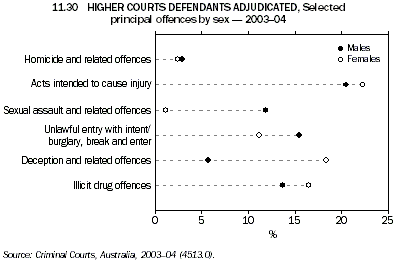
Nationally, the proportions of principal offences for defendants adjudicated were different across age groups in the Higher Courts. Defendants aged less than 20 years were more likely to be adjudicated for a principal offence in the categories of: Unlawful entry with intent/burglary, break and enter (26%); Robbery, extortion and related offences (23%); and Acts intended to cause injury (21%) (graph 11.31). Those within the age group of 45 years and over were more likely to be adjudicated for: Sexual assault and related offences (27%); Illicit drug offences (20%); and Acts intended to cause injury, and Deception and related offences (both 13%).
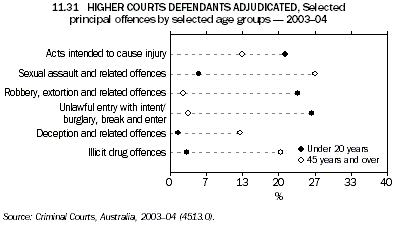
As age increased the proportions of defendants with a principal offence of Road traffic and motor vehicle regulatory offences increased in the Magistrates' Courts. This was the principal offence category for 31% of adjudicated defendants aged less than 20 years, increasing to 51% for defendants aged 45 years and over. Excluding traffic offences, defendants aged less than 20 years were more likely to be adjudicated for a principal offence in the categories of Public order offences (24%) and Theft and related offences (23%). Those 45 years and over were more likely to be adjudicated for Theft and related offences, and Public order offences (both 16%) and Acts intended to cause injury (15%) (graph 11.32).
ADJUDICATED DEFENDANTS BY TYPE OF ADJUDICATION
Nationally, 84% of adjudicated defendants in the Higher Courts were finalised by pleading guilty (table 11.33). Those with the principal offence categories of Weapons and explosives offences (96%) and Unlawful entry with intent/burglary, break and enter (94%) had the highest proportion of defendants finalised with a plea of guilty. In contrast, adjudicated defendants with a principal offence of Homicide and related offences and Sexual assault and related offences were least likely to plead guilty (53% and 62% respectively) and, therefore, most likely to have a trial outcome (acquittal or guilty verdict).
Three categories of principal offences accounted for the majority of trial outcomes in the Higher Courts. These were: Sexual assault and related offences (24%); Acts intended to cause injury (23%); and Illicit drug offences (11%). There were 1,413 (58%) adjudicated defendants with a trial outcome in the Higher Courts with one of these three categories of principal offences.
Across all categories of principal offences, the acquittal rate for Higher Court defendants as a proportion of trial outcomes was 43%. The principal offence with the highest acquittal rate (as a proportion of trial outcomes for this offence type) was Sexual assault and related offences (61%) followed by Acts intended to cause injury (47%). The category of principal offence with the lowest acquittal rate was Illicit drug offences (18%).
Nationally, 93% of adjudicated defendants were proven guilty or pleaded guilty in the Higher Courts, while 96% of adjudicated defendants were proven guilty in the Magistrates' Courts. For combined court levels, defendants with a principal offence of illicit drug offences had the highest proportion of defendants either pleading guilty or proven guilty in both courts (98% for Higher Courts and 99% for Magistrates' Courts). Defendants adjudicated in the Higher and Magistrates' Courts were most likely to be acquitted for the categories of principal offences of Homicide and related offences (17% and 30% respectively), and Sexual assault and related offences (both 23%).
11.33 TOTAL CRIMINAL COURTS ADJUDICATED DEFENDANTS, Principal offence by court level and adjudication type - 2003-04
|
 | Higher Courts | Magistrates' Courts |
 |
|
|
| ASOC Division | Acquitted | Guilty
verdict | Guilty
plea | Total | Acquitted | Proven
guilty | Total(a) |
|
| Homicide and related offences | 70 | 128 | 221 | 419 | 33 | 78 | 111 |
| Acts intended to cause injury | 255 | 291 | 2,566 | 3,112 | 2,764 | 30,230 | 32,995 |
| Sexual assault and related offences | 363 | 230 | 984 | 1,577 | 196 | 673 | 869 |
| Dangerous or negligent acts endangering persons | 13 | 24 | 438 | 475 | 510 | 32,838 | 33,348 |
| Abduction and related offences | 12 | 20 | 84 | 116 | 5 | 31 | 36 |
| Robbery, extortion and related offences | 95 | 125 | 1,464 | 1,684 | 31 | 313 | 344 |
| Unlawful entry with intent/burglary, break and enter | 50 | 93 | 2,103 | 2,246 | 220 | 7,315 | 7,537 |
| Theft and related offences | 22 | 65 | 703 | 790 | 883 | 37,483 | 38,366 |
| Deception and related offences | 31 | 72 | 999 | 1,102 | 408 | 16,449 | 16,857 |
| Illicit drug offences | 49 | 225 | 1,836 | 2,110 | 260 | 28,095 | 28,355 |
| Weapons and explosives offences | - | 3 | 64 | 67 | 120 | 6,213 | 6,333 |
| Property damage and environmental pollution | 17 | 26 | 339 | 382 | 349 | 12,450 | 12,799 |
| Public order offences | 9 | 13 | 194 | 216 | 2,081 | 41,241 | 43,322 |
| Road traffic and motor vehicle regulatory offences | - | 3 | 5 | 8 | 9,169 | 196,503 | 205,672 |
| Offences against justice procedures, government security and government operations | 7 | 20 | 247 | 274 | 977 | 24,527 | 25,504 |
| Miscellaneous offences | 12 | 25 | 258 | 295 | 734 | 13,054 | 13,792 |
| All offence categories(b) | 1,051 | 1,375 | 12,578 | 15,004 | 18,787 | 447,863 | 466,661 |
|
(a) Includes defendants adjudicated n.f.d.
(b) Includes defendants for whom offence data are missing or a principal offence could not be determined.
Source: Criminal Courts, Australia, 2003-04 (4513.0). |
Defendants proven guilty - principal sentence
Defendants proven guilty in the Higher Courts were more likely to receive custodial orders (i.e. custody in a correctional institution or the community or fully suspended sentences) compared with those in the Magistrates' Court (78% and 9% respectively) (graph 11.34). Acts of a more serious nature are usually dealt with in a Higher Court and are, therefore, far more likely to incur a custodial sentence.
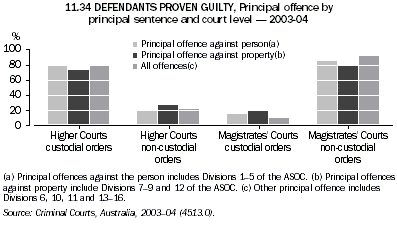
Defendants proven guilty in the Higher Courts incurred a higher proportion of custodial orders (including custody in corrections, custody in the community and fully suspended sentences) than non-custodial orders for most offences. Defendants proven guilty in the Higher Courts for Homicide and related offences; Robbery, extortion and related offences; and Sexual assault and related offences incurred the highest proportion of custodial orders to be served in corrections or the community (87%, 79% and 72% respectively). Defendants proven guilty for Public order offences and Property damage and environmental pollution offences in the Higher Courts incurred the highest proportion of non-custodial sentences (46% and 39% respectively).
Defendants proven guilty in the Magistrates' Courts predominantly received non-custodial sentences for all offences except those in the categories of Robbery, extortion and related offences (51%) and Unlawful entry with intent/burglary, break and enter (51%) (table 11.35).
11.35 DEFENDANTS PROVEN GUILTY, Principal offence by court level and principal sentence - 2003-04 |
|
 | Higher Courts | Magistrates' Courts |
 |
|
|
| ASOC Division(a) | Custody in corrections/ community | Fully suspended sentences | Non-
custodial orders | Total(b)(c) | Custodial orders | Monetary orders | Non-
custodial -other(d) | Total(c) |
|
NUMBER |
|
 |  |  |  |  |  |  |  |  |
| Homicide and related offences | 304 | 39 | 6 | 349 | 23 | 18 | 36 | 78 |
| Acts intended to cause injury | 1,591 | 519 | 740 | 2,857 | 7,321 | 11,877 | 10,901 | 30,230 |
| Sexual assault and related offences | 869 | 187 | 155 | 1,214 | 318 | 131 | 205 | 673 |
| Dangerous or negligent acts endangering persons | 278 | 78 | 106 | 462 | 1,622 | 27,864 | 3,333 | 32,838 |
| Abduction and related offences | 70 | 13 | 21 | 104 | 7 | 7 | 16 | 31 |
| Robbery, extortion and related offences | 1,256 | 196 | 135 | 1,590 | 161 | 30 | 110 | 313 |
| Unlawful entry with intent/burglary, break and enter | 1,384 | 314 | 498 | 2,196 | 3,750 | 1,270 | 2,256 | 7,315 |
| Theft and related offences | 350 | 168 | 249 | 770 | 6,734 | 19,581 | 10,909 | 37,483 |
| Deception and related offences | 539 | 224 | 283 | 1,071 | 2,877 | 8,870 | 4,651 | 16,449 |
| Illicit drug offences | 1,175 | 496 | 388 | 2,059 | 2,506 | 20,313 | 5,218 | 28,095 |
| Weapons and explosives offences | 45 | 12 | 9 | 66 | 640 | 4,339 | 1,194 | 6,213 |
| Property damage and environmental pollution | 146 | 76 | 141 | 363 | 971 | 8,215 | 3,206 | 12,450 |
| Public order offences | 74 | 34 | 95 | 206 | 1,167 | 28,126 | 11,661 | 41,241 |
| Road traffic and motor vehicle regulatory offences | - | - | 4 | 4 | 8,512 | 165,786 | 21,630 | 196,503 |
| Offences against justice procedures, government security and operations | 125 | 72 | 69 | 266 | 2,284 | 17,213 | 4,884 | 24,527 |
| Miscellaneous offences | 148 | 34 | 87 | 283 | 691 | 9,738 | 2,519 | 13,054 |
| All offence categories(e) | 8,354 | 2,462 | 2,986 | 13,945 | 39,638 | 323,543 | 82,784 | 447,863 |
|
PROPORTION (%) |
|
| Homicide and related offences | 87.1 | 11.2 | 1.7 | 100.0 | 29.5 | 23.1 | 46.2 | 100.0 |
| Acts intended to cause injury | 55.7 | 18.2 | 25.9 | 100.0 | 24.2 | 39.3 | 36.1 | 100.0 |
| Sexual assault and related offences | 71.6 | 15.4 | 12.8 | 100.0 | 47.3 | 19.5 | 30.5 | 100.0 |
| Dangerous or negligent acts endangering persons | 60.2 | 16.9 | 22.9 | 100.0 | 4.9 | 84.9 | 10.1 | 100.0 |
| Abduction and related offences | 67.3 | 12.5 | 20.2 | 100.0 | 22.6 | 22.6 | 51.6 | 100.0 |
| Robbery, extortion and related offences | 79.0 | 12.3 | 8.5 | 100.0 | 51.4 | 9.6 | 35.1 | 100.0 |
| Unlawful entry with intent/burglary, break and enter | 63.0 | 14.3 | 22.7 | 100.0 | 51.3 | 17.4 | 30.8 | 100.0 |
| Theft and related offences | 45.5 | 21.8 | 32.3 | 100.0 | 18.0 | 52.2 | 29.1 | 100.0 |
| Deception and related offences | 50.3 | 20.9 | 26.4 | 100.0 | 17.5 | 53.9 | 28.3 | 100.0 |
| Illicit drug offences | 57.1 | 24.1 | 18.8 | 100.0 | 8.9 | 72.3 | 18.6 | 100.0 |
| Weapons and explosives offences | 68.2 | 18.2 | 13.6 | 100.0 | 10.3 | 69.8 | 19.2 | 100.0 |
| Property damage and environmental pollution | 40.2 | 20.9 | 38.8 | 100.0 | 7.8 | 66.0 | 25.8 | 100.0 |
| Public order offences | 35.9 | 16.5 | 46.1 | 100.0 | 2.8 | 68.2 | 28.3 | 100.0 |
| Road traffic and motor vehicle regulatory offences | __ | __ | 100.0 | 100.0 | 4.3 | 84.4 | 11.0 | 100.0 |
| Offences against justice procedures, government security and operations | 47.0 | 27.1 | 25.9 | 100.0 | 9.3 | 70.2 | 19.9 | 100.0 |
| Miscellaneous offences | 52.3 | 12.0 | 30.7 | 100.0 | 5.3 | 74.6 | 19.3 | 100.0 |
| All offence categories(d) | 59.9 | 17.7 | 21.4 | 100.0 | 8.9 | 72.2 | 18.5 | 100.0 |
|
(a) Australian Standard Offence Classification. (b) Includes custodial orders not further defined. (c) Includes defendants for whom a principal sentence is unknown. (d) Includes other non-custodial orders excluding monetary orders. (e) Includes defendants for whom offence data are missing or a principal offence could not be determined.
Source: Criminal Courts, Australia, 2003-04 (4513.0).
|
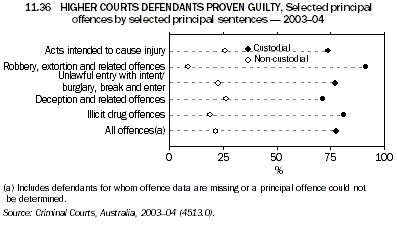 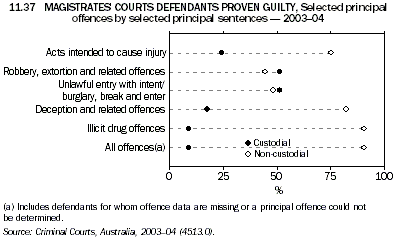
|
 Print Page
Print Page